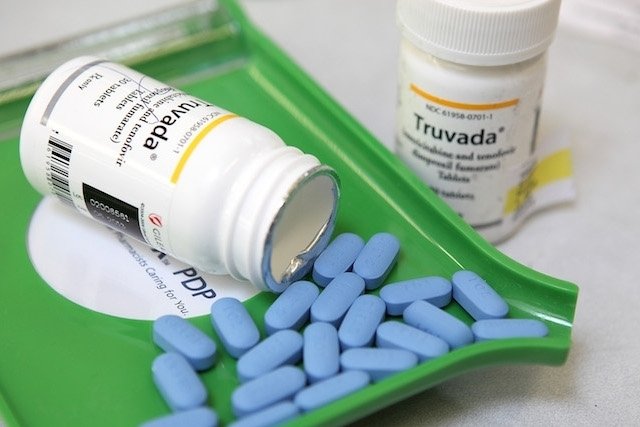There is a lot of scientific research around the cure for AIDS and over the years several advances have emerged, including the complete elimination of the virus in the blood of some people, who are considered to be apparently cured of HIV and should be monitored periodically to confirm the cure.
Although there are already some cases of cure, research into the definitive elimination of the HIV virus still continues, as the treatment that was effective for one person may not be effective for another, especially because the virus is capable of mutating easily, which makes it the most difficult treatment.

Some advances in relation to curing HIV are:
1. Cocktail in just 1 medicine
To treat HIV, it is necessary to use 3 different types of medications daily. An advance in this regard was the creation of a 3-in-1 medicine, which combines the 3 medicines in a single capsule.
This treatment, however, cannot eliminate the HIV viruses from the body, but it can greatly reduce the viral load, leaving HIV undetectable. This does not represent a definitive cure for HIV, because the virus, upon realizing the medication’s action, hides in areas where the medication cannot enter, such as the brain, ovaries and testicles. So, when a person stops taking HIV medication, it quickly starts multiplying again.
2. Combination of five antiretrovirals, gold salt and nicotinamide
Treatment with a combination of 7 different substances has had more positive results because they work together to eliminate the HIV virus from the body. These substances can eliminate viruses that exist in the body, force viruses that have hidden in places such as the brain, ovaries and testicles to appear again, and force cells infected with the virus to commit suicide.
There is human research being carried out in this regard, but the studies have not yet been completed. Although many remaining viruses were eliminated, it was not possible to completely eliminate the HIV viruses. It is believed that after this is possible, further investigation will be needed because each person may need their own specific medication.
3. Vaccine Treatment for HIV-positive people
A therapeutic vaccine has been developed that helps the body recognize cells infected with HIV and must be used in combination with a medicine called Vorinostat, which activates cells that are ‘dormant’ in the body.
In research carried out in the United Kingdom, one patient was able to completely eliminate the HIV virus, but the other 49 participants did not have the same result and therefore more research is needed on its performance until a treatment protocol can be developed that is capable of be applied worldwide. Therefore, more research will be carried out in this direction in the coming years.
4. Stem cell treatment
Another treatment, using stem cells, has also been able to eliminate the HIV virus, but as it involved very complex procedures, it cannot be used on a large scale because this is a complicated and very risky treatment, as around 1 in 5 transplant recipients die during the procedure.
Timothy Ray Brown was the first patient to be cured of AIDS after undergoing a bone marrow transplant to treat leukemia and after the procedure his viral load decreased more and more until the latest tests confirmed that he is currently HIV negative and it can be said that he is the first man to be cured of AIDS in the entire world.
Timothy received stem cells from a man who had a genetic mutation that only about 1% of the northern European population has: The absence of the CCR5 receptor, which makes him naturally resistant to the HIV virus. This meant that the patient no longer produced HIV-infected cells and, with treatment, the cells that were already infected were eliminated.

5. Use by PEP
Post-exposure prophylaxis, also called PEP, is a type of treatment that consists of using medications immediately after risk behavior, where the person may have been infected. As in this immediate period after the behavior there are still few viruses circulating in the blood, there is the possibility of a ‘cure’. That is, theoretically the person was infected with the HIV virus but received treatment early and this was enough to completely eliminate HIV.
It is important that these medications are used within the first two hours after exposure, as this will be more effective. Even so, it is important that tests are carried out to detect the HIV virus 30 and 90 days after unprotected sexual intercourse.
This medicine reduces the chances of being contaminated sexually by 100% and by 70% through the use of shared syringes. However, its use does not exclude the need to use condoms in all intimate contact, nor does it exclude other forms of HIV prevention.
Find out more about PEP and how it works.
6. Gene therapy and nanotechnology
Another possible way to cure HIV is through gene therapy, which consists of modifying the structure of the viruses present in the body, in a way that prevents them from multiplying. Nanotechnology can also be useful and corresponds to a technique in which it is possible to place all the mechanisms to combat the virus in just 1 capsule, which must be taken by the patient for a few months, being a more efficient treatment with fewer harmful effects.
Because AIDS still has no cure
AIDS is a serious disease that does not yet have a definitive cure, but there are treatments that can greatly reduce the viral load and prolong the life of an HIV-positive person, improving the person’s quality of life.
Currently, the treatment of HIV infection on a large scale is carried out using a cocktail of medications, which, despite not being able to completely eliminate the HIV virus from the blood, can increase a person’s life expectancy. Find out more about this cocktail in: AIDS Treatment.
The definitive cure for AIDS has not yet been discovered, however it is close, and it is important that patients who have been considered cured of the disease are periodically monitored to check how the immune system is reacting and if there are any signs that indicate the presence of the HIV virus. .
It is believed that the elimination of the HIV virus may be related to the correct activation of the immune system and may occur when the person’s body is able to identify the virus and all its mutations, being able to eliminate them completely, or through new technologies that They are not exactly aimed at stimulating the immune system, as is the case with gene therapy and nanotechnology, which act in different ways.

Sign up for our newsletter and stay up to date with exclusive news
that can transform your routine!
Warning: Undefined array key "title" in /home/storelat/public_html/wp-content/plugins/link-whisper-premium/templates/frontend/related-posts.php on line 12
Warning: Undefined array key "title_tag" in /home/storelat/public_html/wp-content/plugins/link-whisper-premium/templates/frontend/related-posts.php on line 13



